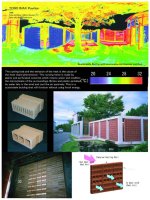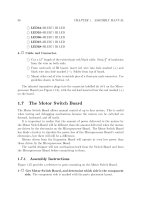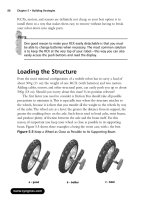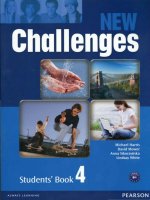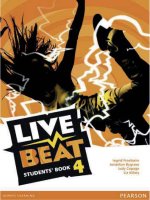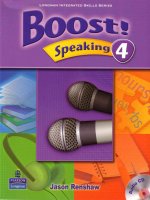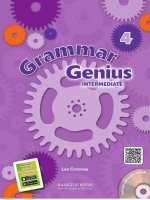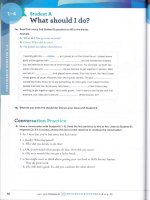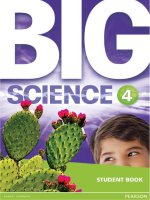Building blocks year 4 sb
Bạn đang xem bản rút gọn của tài liệu. Xem và tải ngay bản đầy đủ của tài liệu tại đây (31.04 MB, 94 trang )
Building Blocks: Grammar,
Punctuation and Handwriting
Year 4 Student
Book
Hannah Hirst-Dunton
Published by Pearson Education Limited, 80 Strand, London, WC2R ORL.
www.pearsonglobalschools.com
Text © Pearson Education Limited 2020
Designed by Pearson Education Limited 2020
Typeset by PDQ Digital Media Solutions Ltd
Project managed by Just Content Ltd
Produced by Just Content Ltd and Danielle Whisker
Edited by Carole Sunderland and Jane Morgan
Original illustrations © Pearson Education Limited 2020
Illustrated by PDQ Digital Media Solutions Ltd
Cover design © Pearson Education Limited 2020
The right of Hannah Hirst-Dunton to be identified as the author of this work has been asserted
by her in accordance with the Copyright, Designs and Patents Act 1988.
First published 2020
222120
10987654321
British Library Cataloguing in Publication Data
A catalogue record for this book is available from the British Library
ISBN 4978 | 292 37393 5
Copyright notice
All rights reserved. No part of this publication may be reproduced in any form or by any means
(including photocopying or storing it in any medium by electronic means and whether or not
transiently or incidentally to some other use of this publication) without the written permission
of the copyright owner, except in accordance with the provisions of the Copyright, Designs and
Patents Act 1988 or under the terms of a licence issued by the Copyright Licensing Agency, 5th
Floor, Shackleton House, 4 Battle Bridge Lane, London, SEI 2HX (www.cla.co.uk). Applications
for the copyright owner’s written permission should be addressed to the publisher.
Printed in Slovakia by Neografia
CONTENTS
Introduction
Unit 1 Further conjunctions
Lesson 1 Revisiting conjunctions
Lesson 2 Understanding ‘or’ and ‘so’
Lesson 3 Using ‘or’ and ‘so’
Lesson 4 Understanding clauses
Unit 1 Checkpoints
Unit 2 Irregular verbs
Lesson 1 Understanding ‘be’ and ‘have’
Lesson 2 Understanding other irregular verbs
Lesson 3 Writing with irregular verbs
Lesson 4 Ensuring verb agreement
Unit 2 Checkpoints
Unit 3 Adverbials
Lesson 1 Understanding adverbs
‘Lesson 2 Adding adverbs of time and manner
Lesson 3 Identifying adverbial phrases
Lesson 4 Writing with adverbials
Unit 3 Checkpoints
Unit 4 Demonstratives
Lesson 1 Understanding demonstrative determiners
Lesson 2 Using demonstrative determiners
Lesson 3 Understanding demonstrative pronouns
Lesson 4 Using demonstrative pronouns
Unit 4 Checkpoints
Unit 5 Possession
42
Lesson 1 Understanding singular possessive nouns
42
Lesson 2 Using singular possessive nouns
44
Lesson 3 Identifying possessive pronouns
46
Lesson 4 Understanding possessive determiners
48
Lesson 5 Using possessive determiners
50
Lesson 6 Understanding independent possessive pronouns
52
Lesson 7 Using independent possessive pronouns
54
Lesson 8 Selecting possessive pronouns
56
Unit 5 Checkpoints
58
Unit 6 Punctuation
60
Lesson 1 Revising sentence punctuation
60
Lesson 2 Revising lists
62
Lesson 3 Revising direct speech
64
Lesson 4 Punctuating speech
66
Unit 6 Checkpoints
68
Handwriting
70
Glossary
86
Welcome to Building Blocks
Learning the rules of Standard English and formal grammar may seem a bit like learning
a different language. However, it is very useful — it can help you to express yourself with
many different people in many different places.
We hope you will find this Student Book useful as you develop your grammar and
punctuation skills. It is divided into units, and each unit is divided into lessons.
The three activities you will find in each lesson focus on practising key skills and building up
your understanding. The ‘Grammar guides’ in each lesson point out the key learning points
for you. At the end of each lesson, the checkpoints offer you a quick and easy way to show
how confident you feel about the skills you’ve been taught.
¬-
nh
There are three activities
in every lesson. Activity
Lesson 5
1 is usually very short.
Activity |
Activities 2 and 3 will take
|
LH
J
ASSASSIN
Each ‘Grammar guide’
clearly highlights the key
Mum chopped the potato, a carrot and an onion.
:
© Use ‘the’ when you talk about a particular thing.
:
© Use ‘a’ or ‘an’ when you talk about any thing.
:
© Use ‘an’ before words beginning with ‘a’, ‘e’, , 0
1bsSseseseâeeâeeseeeeeeeeeooeooeeeoeâeoâ đ%ââââ5d696669666666666666666s666
@ Elephants are the biggest animals we saw.
simple response, like ticking
a box or writing one word.
Other activities require you
@ Amrit climbed the tree in the forest.
or even paragraphs.
:
°°
{ Tick the sentences that use ‘the’, ‘a’ and ‘an’ correctly. ]
Some activities need a
to write phrases, sentences
:
© Use ‘a’ before words beginning with any other letter.
7
(See
ee
ee
22^222112110162<2 1122292469220002đÁ£
Oru.
learning points in the lesson.
`
n
Thổ
© Crack a egg into the bowl.
@ Can! have a grape from the bunch?
OOOO
\
longer to complete.
Lesson 1
know
what
wnat
dent
.
a noun ts
:
â ()
đ(3
|
| can identify a noun in a sentence.
Lesson 2
| can choose nouns to complete sentences.
Lesson 3
|
Checkpoints at the end of every
lesson let you quickly show how
Di
in
well uou think uou are doing.
oe
@ C)
OO.)
Remember, you can ask an adult
for extra help with things you’re
finding tricky!
@C )
| know what a plural noun is.
©{
)
@ C)
| can identify plural nouns.
SE
The final section is handwriting practice, designed for you to work through
at your own pace. Enjoy practising your handwriting with interesting and
exciting activities, and becoming familiar with the English alphabet. With lots
of support across all the year groups, soon you will be confident, whatever you
need to write!
With you as you learn
Meet grammar-loving Gon. He’s a lot of fun and is
always the first into the playground at lunchtime.
Gon is determined, however tricky something looks!
Meet Paz, the punctuation master. She’s shy, but she’s
always more than happy to help a friend in need! Paz
always thinks carefully about the choices she makes.
Unit 1: Further conjunctions
_ kesson [: Revisiting conjunctions
Activity |
0.2 ©.0.0
Grammar
guide
0.0.0.0.
0 0.0.0.0
0 00.00.0000
0000
0000000000
00000000000
The door opened. | hurried outside.
The door opened and! hurried outside.
I hurried outside but Mum called me back.
Mum called me back because| needed my coat.
©
Sentences can be linked to form longer sentences.
©
The original sentences become clauses in the new sentence.
©
Linking words such as ‘and’, ‘but’ and ‘because’ are called conjunctions.
©
The conjunction ‘and’ links similar ideas.
©
The conjunction ‘but’ links contrasting ideas.
9
The conjunction because goes before a reason.
'e@eeeeeâeââeâââo6âeâeâeeeeeoeeoeeoeeeoeoeeeooeoeoeeeoeoeoeooeoeooeeoeoeeoeoooeeeeoeoeoeeoeoeđ
Link each pair of clauses using ‘and’, ‘but’ or ‘because’.
Use each word only once.
@
|
|
| wanted to plau basketbal_——
but
wanted to watch a film.
@
Westayedinside
@®
We played basketball
a film.
—
=
mụbrother
itWasraining.
—
thenawewatched
|
FƑ
Unit 1 | Lesson 1:Revisiting conjunctions
Activity 2
@ |
Say two sentences about two things that you like to eat.
Write them as one sentence, using ‘and’.
©|
Say two sentences, one about an activity that you like and
one about an activity that you do not like. Write them as one
sentence, using ‘but’.
©|
Say asentence about something that you chose to do recently.
Say a second sentence describing the reason that you chose to do
this. Write them as one sentence, using ‘because’.
Activity 3
[ Look again at your answers to Activity 2. |
®
[ Circle each conjunction that you used. J
6
[ Underline each clause that you wrote.
|
Unit 1 | Lesson 2: Understanding ‘or’ and ‘so’
- Lesson 2
Activity |
l,đ.e.0.â
Grammar
guide
â, 0.0.0.0. 0.0.0, 0.0.0 .â.0.0.0.0.0. 0.0.0
0.0.0. 0.0.0.0. 0.0.0.0.0.0.0
0.0. 0.0000
00
It is raining. It is sunny. > It is raining or it is sunny.
It is raining. | use an umbrella. > It is raining so | use an umbrella.
©
Conjunctions link sentences to form one longer sentence.
@
The words ‘and’, ‘but’ and ‘because’ are conjunctions.
©
The words ‘or’ and ‘so’ are also conjunctions.
©
The original sentences become clauses in the new sentence.
e
"@SSHSSHSHOHSHOHSHHSHSHSHOHHSSHOHHSHHHSHHHHHHHHHHHHHHHHHHHHHOHHHHHHOHHHOHOHE®
Underline the conjunctions.
| didn’t have a great day. | wanted to go out because it was warm.
| called my friend and | grabbed my frisbee. We could go to the park
or we could use the school field. We chose the park but that was a
mistake. It was a public holiday so the place was crowded. We left
because we could not play. By then, it was too late to get to the
school field!
Grammar
guide
©.0.©.0.0.0
©
0.0.6
6.0.0 .0.0.0.0.0.0.0.0.0.0.0.0.0.0.0,.0.0.0.0,0.0.0.0.0,.0.0.0
00.0
It is raining or it is sunny.
It is raining so | use an umbrella.
©
The word ‘or’ links two possible things. Only one of them can happen
or be true.
e
The word ‘so’ introduces an effect.
si
e
eeee
đeeoeoeeoeeeoeeeoeoooeeooâ
Activity 2
i
i iii
ilies
Unit 1 | Lesson 2: Understanding ‘or’ and ‘so’
Ị
Z
Tick one box to show what each connecting word suggests.
The second idea
These are two possibilities.(__)
@ | play with Salib | These are similar ideas.
(__)
.
or | play with
i
These are contrasting
Jess.
These are two possibilities.( )
© Dad was
annoyed
because the
train was late.
@ Nish reads his
e
peas
enjoys it.
@ | felt ill so we
went to see the
doctor.
ideas.
These are similar ideas.
These are contrasting
ideas.
C)
(__)
G
These are two possibilities. =
| These are similar ideas.
These are contrasting
ideas.
(__)
()
These are two possibilities.(__)
These are similar ideas.
These are contrasting
ideas.
is a reason.
(__)
CO
These are two possibilities.(__)
is an effect.
[OO
but Elli was late. | ideas.
The second idea
The second idea
is a reason.
The second idea
ï
is an effect.
The second idea
is a reason.
The second idea
is an effect.
JOO
These are contrasting
(_)
JOO
@ Bill was early
These are similar ideas.
J
The second idea
is a reason.
The second idea
is an effect.
The second idea
is a reason.
The second idea
is an effect.
OOJOO0
\
Activity 3
[ Cross out the incorrect conjunction in each sentence. ]
@
@|
®
[ | will wear a coat so / or | will be cold. J
sophie could jog in the park so / or she could cycle there. J
[ Darren picked up the baby so / or she stopped crying. ]
© [ we went to the cinema so / or we could watch a film. ]
|
5
Unit 1 | Lesson 3: Using ‘or’ and ‘so!
' Lesson 3
Activity |
đeđ@eeđ
Grammar
guide
đ@đâGđâđ0â0o9â06âG6âe906060606090696âe06oe6oee60eoe6oeoeooeoeoeoeooeooeeeoeooeoee
I
:
â
Conjunctions link sentences to form one longer sentence.
â
The words ‘or’ and ‘so’ are conjunctions.
©
The word ‘or’ links two possible things. Only one of them can happen or
be true.
@
The word ‘so’ introduces an effect.
ị
°
®
[ Link this pair of sentences using ‘so’. ]
[ | missed my gran. | went to visit her. ]
| missed
®
my gran
[ Link this pair of sentences using ‘or’. J
[ We can go swimming. We can play mini golf. }
We can
go swimming
||
Ị
|
|
|
i}
|
|
Unit 1 | Lesson 3: Using ‘or’ and ‘so’
Activity 2
Say two sentences that describe two possible games you could
®
play. Write them as one sentence, using ‘or’.
We could play
@|
Say asentence describing the weather. Say another sentence
describing the effect of that weather on what you can do. Write
them as one sentence, using ‘so’.
Activity 3
=
`
Draw lines to show which word would best connect each pair of sentences. J
mm...
Sam washed the car.
(Kae
Phyllis helped him.
(EN
| broke a window.
| was grounded.
SE
oe
(Se
a
RGae
Maybelle GOUlago out.
She could stay in.
Set
as ve
eR RCTS
| ate lots of breakfast.
| was hungry.
SiS Sc
dace
(Eee
The sun is out.
The wind is cold.
NGHHHi==r====——
ee
ana
See ee
(a
Bie
Cee)
(Se
hecauce
"—
Unit 1 | Lesson 4: Understanding clauses
}
Lesson 4
Activity |
|@-¢¢.0-0 MCT gel palnatelg
guide
đ;đ;â:â:â;:o:â.e.e-eo:â.o:o:o.o.â.@.e.o.â.â.e.o:e:e.e.â.o.e.âo.o.oe@.ee,eâ.o.đâ.â
The weather looks stormy. Achak stays inside.
The weather looks stormy so Achak stays inside.
°
?
©
Sentences become clauses when they become part of a longer sentence.
›
©
Clauses, like sentences, need a subject and a verb.
e
e
:
It was already 10 o’clock. | had slept in so | was late for band
practice! | hurried but | felt bad because | was late last week, too.
Now | was worried. Would my friends be cross with me or would
they laugh? | ran in and | apologised straight away.
[ Underline the clauses in the paragraph above. How many are there? ]
@eeee
Grammar
guide
0.0
©
0.0.0.0. ©. 0.0.0. 0.0.0.0
0. 0.0.0.0.0.0.0.0.0
0.0.00. 0. 0.0.0.0,0.0.0.0.0
0.0.0.6
It was bright but it was cold. It was cold but it was bright.
e
Amain clause gives the main point in a sentence.
©
There can be more than one main clause in a sentence if they are
equally important.
©
Swapping the order of two main clauses does not affect the meaning of
a sentence.
The snow fell so | made a snowman. | made a snowman so the snow fell.
e
Asubordinate clause gives extra information that is not the key point.
©
Swapping a main clause and a subordinate clause does affect the
meaning of a sentence, or makes no sense.
đ0060đââ@ââââ66âeeâ6ââ6â666666666G666666â6G6666606066e6696666696666066oeoeooooeoeoeđ
TW...TT
Unit 1 | Lesson 4: Understanding clauses
a
[ Tick the sentences that include subordinate clauses.
©
We went to a theme park because it was my birthday.
©
We could go on rides or we could see a music show.
e
We got there early so the queues were short.
@
The shop was big and it was crowded.
©
The day out was exhausting but | loved it!
]
OO0O08
pP
( Write a short sentence containing two main clauses, using or. J
đ
â|
Write a short sentence containing a main clause and a
subordinate clause, using ‘so’.
Activity 3
fŒŒm.m...................òằê..
It was bright but it was cold. The snow fell so | made a snowman.
©
Acoordinating conjunction links main clauses together.
The conjunctions ‘and’, ‘but’ and ‘or’ are coordinating conjunctions.
e
Asubordinating conjunction introduces a subordinate clause.
The conjunctions ‘because’ and ‘so’ are subordinating conjunctions.
OO
ERENT
REDE
RRR
CR
ETE
NORE
DECREE
HET
[ Circle the subordinating conjunctions. }
=9) =) 6) G)
i t eee:
ee
es
a
Bướngh
9 J
Unit 1 | Checkpoints
Unit | Checkpoints
Lesson
1
OO)O
| know what a conjunction is.
@
| know what a clause is.
©
| can choose ‘and’, ‘but’ or because to connect
two clauses.
â =
đ C)
| can say and then write sentences using ‘and’, ‘but’
© C)
©
QO
and ‘because’.
Lesson 2
@ (_)
| know the conjunctions ‘and’, ‘but’, ‘because’, ‘or’ and ‘so’.
OO
® G
| know that ‘or’ links two possible things.
OO
@ G
| know that ‘so’ introduces an effect.
OO
® G
Unit 1 | Checkpoints
Lesson 3
| can link sentences using ‘or’ and ‘so’.
@
OQ
| can say and then write sentences using ‘or’ and ‘so’.
®
O
| can use ‘and’, ‘but’, ‘because’, ‘or’ or ‘so’ to connect
© ()
two ideas.
@ (_)
Lesson 4
| can identify clauses in sentences.
@
OC)
| know what main clauses and subordinate clauses are.
®
G
| can identify main clauses and subordinate clauses.
®
OC)
| know what coordinating conjunctions and subordinating
© ()
conjunctions are.
@ C)
| can identify subordinating conjunctions.
OO
@ a
|
|
11
Unit 2: Irregular verbs
Lesson |: Understanding ‘be’ and ‘have’
Activity |
2000
Grammar
e
guide
©0660.
0.0. 0.0.0.0. 0.0
0. 0.0.0.0
0.000.000
0.00.000000000000000
An irregular verb does not follow rules.
© The only irregular present-tense verbs are ‘be’ and ‘have’.
©
The verbs ‘be’ and have are also irregular in the past tense.
9âe@6@6ââ6@6@666â66â6â6â666666666666666666666666666â666G6060666666606666666e9đ
Z
`
Complete the table with the correct verb forms. J
HAVE
Present tense
I
12
have
BE
Past tense
Present tense
{I
|
You
. | You
You
. | You
He
lt
She
lt
We
We
We
am
Past tense
I
We
You
. | You
You
. | You
They
. | They
They
. | They
|
Unit 2 | Lesson 1: Understanding 'be' and ‘have'
Activity 2
®
G
\
(
Complete the story with the correct present-tense forms of
the verb ‘have’.
Every night, !__have the same dream.You__——_
a box with two big locks. Your brother ______
We_ ——
Ự
|
|
Gị
|
¬
-
`
the key.
arace to get them. Then we see that theu
broken ends and can’t be used.
]
⁄
`
“
`
Complete the storu with the correct past-tense ƒorms oƒ the
§ verb ‘be’.
We_ W€@r€
—
alLin the school plau. The setting
a dangerous city. Pete _____
and he robbed a bank. You___
the villain
the manager and
Jamala________ a police officer. The other students
citizens.|__———— the detective and I
`Š
stopped the thief. You____all
very grateful.
Activity 3
@|
Look again at the story in Activity 2, question 1.
With a partner, say the story in the past tense.
@ |
Look again at the story in Activity 2,
question 2. With a partner, say the story in
the present tense.
Unit 2 | Lesson 2: Understanding other irregular verbs
-_ Lesson 2
©0006
Grammar
guide
@.0.0. 0.0
©.0.0.0.0.0
O.0.0.0,0.0,0.0.0,0.0.0.0
0.0.0 0.0.0.0. 0.0.0 0.0.6 6.0 00.0.0
©
Irregular verbs do not follow rules.
©
They must still match their subject (who or what does the action).
©
They must still match their tense (when the action happens).
©
There are lots of verbs with irregular past tenses. These just have to
be learned.
đeeoeeeeoeoeoeoeoeeoeSâSâ
Activity |
Z
Complete the tables b writing the present-tense version oƒ
each irregular past-tense verb.
C
Present
|
She
14
write
Past tense
tense
-
Present tense
Past tense
| wrote.
| grew.
She ƒelt.
It found.
Unit 2 | Lesson 2: Understanding
other irregular verbs
Activity 2
⁄
\
Complete the tables bụ writing the irregular
past-tense version oƒ each present-tense verb.
Present tense
| say.
You go.
Past tense
¡I__ sai
——.
Present. tense
| get.
Past tense
|
You _——————.
You give.
You
He takes.
She
She runs.
She
We come.
We
We think.
We
You see.
You
You tell.
You
They know.
They
They can.
They
Activity 3
(7
\
The students begin their lesson today with a song. They sing together
and then they read. They speak about their books and they make sure
that they understand the topic.
Z
`
Change the verbs to put the story into the past tense. J
z
The students
their lesson today with
asong. They
together and then they
. They
about their books and they
ee
`.
the topic.
sure that they
A
Unit 2 | Lesson 3: Writing with irregular verbs
- Lesson 3
Activity |
p>e@eee@
Grammar
guide
9:9,9.9:9.9.9.9:9.9.9.9.9:9.9:9.9.9.9.9.9.9:.9.9.9.9.9:9.9.9.9.9.9.9.9.9.9.9.9.9.9.9.9.©
e
Irregular verbs do not follow the usual rules.
e@
They must still match their subject (who or what does the action).
e
They must still match their tense (when the action happens).
©
There are lots of verbs with irregular past tenses. These just have to
be learned.
beeeeeoeoeeoeeoeoeoeoeoâeoeoeoeooooeeooeoeoooo6oeooooooeooeoeooooeoeeoeoeoeeoeoeoeeoeooooeđ
fi
Complete the tables to show the irregular past-tense version
of each present-tense verb.
Present tense
| go.
You take.
Past tense
|___went _,
You
Present tense
| bring.
You give.
Past tense
|
You
Unit 2 | Lesson 3: Writing with irregular verbs
:
Activity 2
Write three sentences in the past tense. Write about things that have
happened to you today.
Use the past-tense forms of at least three of these irregular verbs.
=) =) 6) œ) ) 1
ee
na mm
Activity 3
[ Change the sentences that your teacher says into the past tense. ]
Sentence 1:
Sentence 2:
Unit 2 | Lesson 4: Ensuring verb agreement
' Lesson 4
Activity |
Grammar
guide
$:9:9.9.9.9.9.9.9.9.9.9.9.9.9.9.9.9.9.9:9.9.9.9.9:.9.9.9:.9.9.9.9.0.9.9.9.9.9.9.9.e.9.9
e
Verbs must match their subject: who does the action.
©
They must also match their tense: when the action happens.
@
This matching is called verb agreement.
@eeâeâââ6â6âââ666666666666666â6â6â6â6â66e6âe6ââeâeoeoeâeeooooooeoeooeeoeoeoeeeoooeoeođ
[ Underline the incorrect past-tense verbs. ]
At my new school, we wear a uniform. At my old school, we choosed
what to wear. | usually weared smart clothes, but many others did
not. | thinked a uniform would be worse, but then | changed my mind.
©
[ wee the correct past tenses here. J
Verb 1:
Verb 2:
Verb 3:
18
đeeeeooeeeeee
seeâeeâ
Unit 2 | Lesson 4: Ensuring verb agreement
Activity 2
This story contains verbs that do not agree with their subject or the tense.
—
C
“
On Saturdays, Uncle Hiro and | bakes cupcakes. Last week, he comes
over with a recipe he wrote. We has fun with the mixing and then we
waited for them to cook. They was very tasty!
Write the incorrect verbs in the first column of the table.
Write the correct versions in the second column.
\.
What are the incorrect verbs? | What would be the correct verb form?
Verb 1:
bakes
Verb 2:
Verb 3:
Verb 4:
Activity 3
(7
`
Look again at the verbs that you identified in Activity 2. Add them
to the first column of the table below. Then tick one box to show
why you needed to correct each of them.
What are the incorrect verbs?
What did the verb not match?
Verb 1: bakes
| (_) subject
(_) tense
(_) both
vrb2.——
_) subject’
=) tense
_) both
wrb3:———_|(
)subjet ()tese
(_) both
| verbs;
|( )subjet ( )tense
()both -
19

